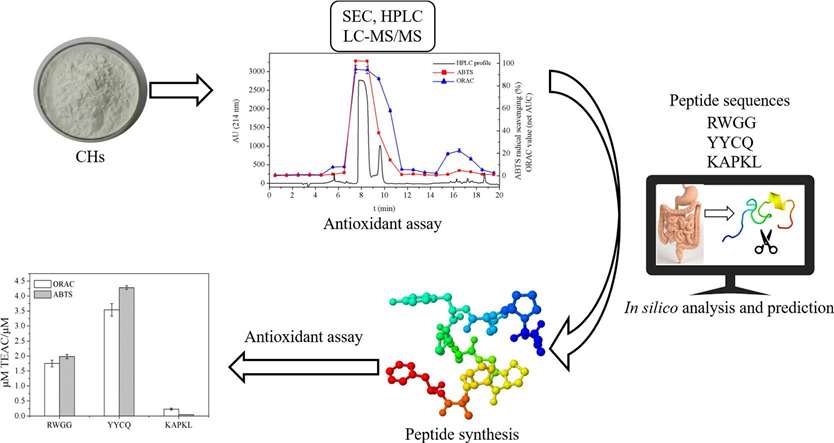Peptides are low molecular weight protein fragments that play important roles in various life activities. Known active peptides in organisms are mainly produced or obtained from endocrine gland tissues and organs, secretory cells and body fluids, and are closely related to active peptides in cell differentiation, neurohormonal transmitter regulation, tumor lesions, immune regulation, in life activities.
Peptide analysis refers to the process of studying and analyzing peptide molecules in organisms. Peptide analysis is a high-throughput comprehensive identification of all endogenous bioactive peptides in an organism, cell or tissue at a specific time space. The analysis of peptides provides information about their structure, function, interactions, and biosynthetic pathways.
 Fig. 1. Analysis of antioxidant peptides (Food Research International. 2022, 157: 111253).
Fig. 1. Analysis of antioxidant peptides (Food Research International. 2022, 157: 111253).
Mass spectrometry can be used to determine the molecular weight, sequence, modifications, structure and other information of peptides. Common mass spectrometry methods include mass spectrometer, analysis of mass spectrometry profiles and comparison of databases.
Common chromatographic techniques include high-performance liquid chromatography (HPLC), gas chromatography (GC), ion exchange chromatography (IEC), reversed-phase chromatography and so on. These techniques can be used for purification, separation and quantitative analysis of peptides.
NMR techniques can provide structural and kinetic information about peptides. By measuring the resonance signals of the nuclei of hydrogen, carbon and other atoms in a peptide molecule, the stereo structure, helical conformation, of the peptide can be determined.
In proteomics, peptide analysis is an important part of it. Through high-throughput mass spectrometry, complex protein mixtures can be identified and quantitatively analyzed to obtain information on peptides.
Protein microarrays utilize peptides or protein fragments immobilized on solid-phase support materials to interact with peptides in the samples to be tested, thus enabling screening, identification and quantitative analysis of peptides.
Enzymatic cleavage technique reveals sequence and modification information of a peptide by cleaving the peptide using a specific protease to generate a specific fragment. Commonly used enzymes include trypsin and pepsin.
Peptide mapping analysis is based on the molecular weight of proteins and peptides and the characteristics of amino acid composition, the use of more specific protein hydrolases to act on special peptide chain sites to cleave the peptide into small fragments, and the formation of characteristic fingerprints through a certain means of separation and detection, peptide mapping analysis of peptide structure research and identification of characteristics is of great significance.
Peptide analysis can be used to determine the structure, purity, activity, stability and other properties of peptide drug candidates, assess their pharmacokinetics and toxicity, and optimize peptide drug design and optimization.
As intercellular signaling molecules, peptides are involved in the regulation of a variety of biological processes, such as cell proliferation, differentiation and apoptosis. Through peptide analysis, the processes of peptide synthesis, release, receptor binding and signaling can be studied, revealing the mechanism of cell signaling pathways.
Peptide analysis can be used to study various modifications of proteins, such as phosphorylation, methylation, acetylation and so on. These modifications have an important impact on protein structure and function. Peptide analysis can identify and quantitatively analyze peptides in different modification states, revealing the regulatory effects of modifications on proteins.
Reference